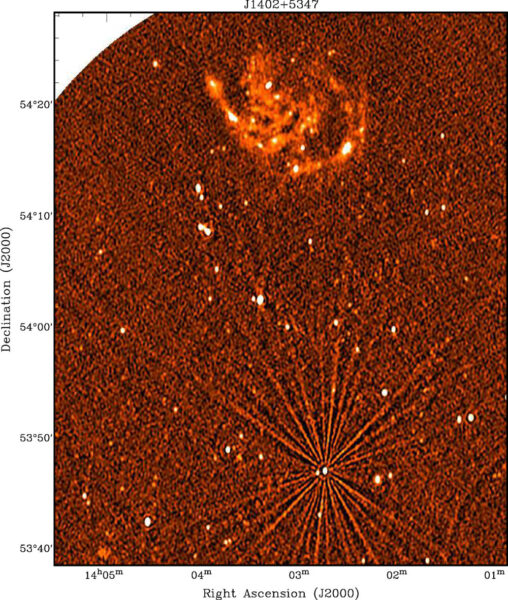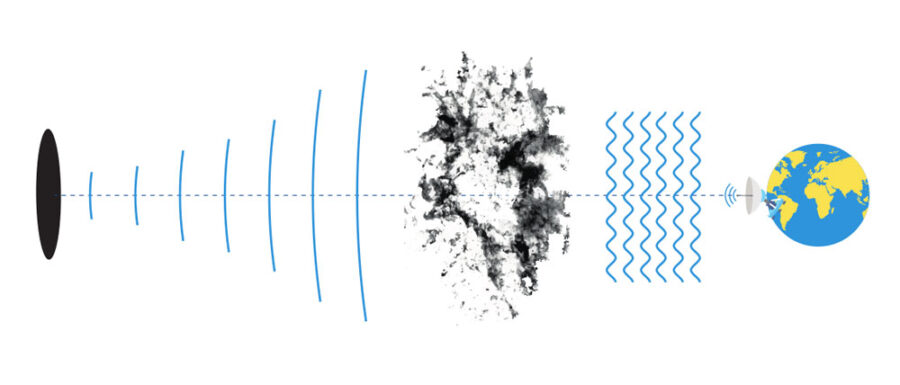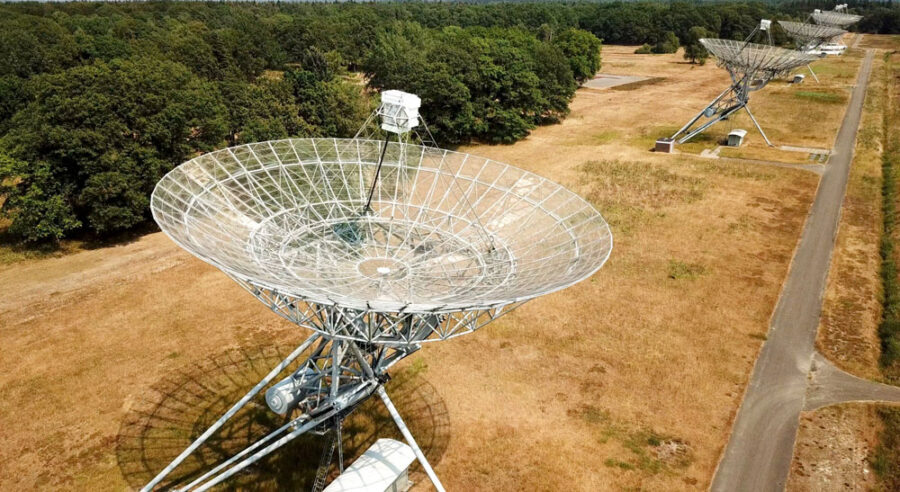Radio observations have turned up evidence of a cloud of hot plasma near — or even in — the solar system. But its distance estimate is still up for debate.

Tom Oosterloo / ASTRON
Radio astronomers have detected a cloud of hot plasma at the edge of the solar system, and no one has a clue about its nature or origin.
Researchers didn’t observe the mystery cloud directly. Instead, they saw its effect on the radio waves of a background quasar known as J1402+5347. Its presence caused the quasar’s light to flicker on a timescale of minutes. “It’s a spectacular twinkler, and a very nice surprise,” says Mark Walker (Manly Astrophysics, Australia), who studies intra-hour variability of quasars but wasn’t involved in the new work.
Until recently, astronomers knew of three rapidly twinkling quasars, whose scintillations suggested the presence of plasma clouds at distances of a few tens of light-years. But the new cloud is much closer, says study lead Tom Oosterloo (ASTRON Netherlands Institute for Radio Astronomy).
Interstellar radio scintillation produces a speckle pattern, comparable to the speckle pattern in the optical image of a star that results from atmospheric turbulence. As Earth moves through that pattern, astronomers observe rapid brightness variations. “From the observed twinkle frequency of J1402+5347,” Oosterloo says, “we deduce a distance of just 0.8 light-years for the plasma screen, which is within the solar system’s Oort cloud.”

ASTRON / Studio Eigen Merk
The discovery is the first published scientific result obtained with the new wide-angle Apertif receivers (Aperture Tile In Focus) on ASTRON’s venerable 14-dish Westerbork Synthesis Radio Telescope. Apertif increased the instrument’s field of view by a factor of 40, making it much easier to find rare sources.
The plasma cloud, thought to be at least a few billion kilometers (several astronomical units) across, could be an interloper from interstellar space. Or it could be some kind of remnant from the formation of the solar system, says Oosterloo. “That would be really exciting.”
However, Walker isn’t so sure about the cloud’s estimated proximity, which is based on a simple, idealized model. Each of the previously known twinkling quasars appeared to be associated with a nearby hot star (Vega, Spica, and Alhakim or Iota Centauri, respectively), suggesting that the intervening plasma was somehow expelled by the star.
As Oosterloo and his colleagues discuss in their Astronomy & Astrophysics paper, the new quasar’s sky position is close to Alkaid (Eta Ursae Majoris), which is just over 100 light-years from Earth. “It’s very unlikely that we’d get a random coincidence between [a twinkler] and a hot star like Alkaid,” says Walker. “The chances are less than one in 1,000 for a match as close as this — so my guess is that they are indeed physically related.”

ASTRON
But according to Oosterloo, that would imply an improbably compact and extremely elongated plasma cloud. Moreover, since the team serendipitously found the new intra-hour variable quasar in April 2019, they’ve discovered 10 more of these rare sources that do not seem to be associated with nearby stars, though the intervening plasma appears to be many light-years away in these newer cases.
Radio astronomer Hayley Bignall (CSIRO, Australia), who was also not involved in the new study, says she would “naively agree with the arguments the authors make for a very nearby plasma screen. On its own, I would say the case for the very small distance is compelling, but not 100% convincing.” Follow-up observations at other wavelengths and the study of additional twinkling quasars would help strengthen or refute the claim, Bignall says.
 3
3









Comments
Howard
September 1, 2020 at 6:38 pm
A possible source for this plasma cloud is the heliosheath - the heliosphere boundary that separates our solar system from interstellar space. The recent passage of the two Voyager spacecraft through the heliosheath showed it to be a much thicker and denser plasma than originally thought.
The heliosheath is known to approximate a distorted ellipsoid so if in fact these plasma clouds are ubiquitous in the heliosheath they could be responsible for the observed quadrupole and octupole anomalies in the CMB Planck observations.
You must be logged in to post a comment.
Yaron Sheffer
September 4, 2020 at 5:03 pm
Howard, their estimated distance is 0.8 LY, or about 50,000 AU. The voyagers are less than 150 AU from us, more than 300 times closer than 0.8 LY away. Perhaps this rules out the heliosheath as a player in this game?
You must be logged in to post a comment.
Howard
September 5, 2020 at 12:51 pm
If you look at the wording in their abstract ( I have requested the full paper) it reads as follows:
"The canonical theory of refractive scintillation constrains the scattering plasma to be within the Oort cloud. "
So their results do not rule out that the plasma source could be closer than the Oort cloud ( and less dense then ).
Still one has to wonder what the effect of these plasma refractions would be on the CMB-deduced temperature fluctuations and the various multipole anomalies that have yet to be solved.
You must be logged in to post a comment.
You must be logged in to post a comment.